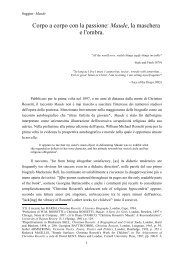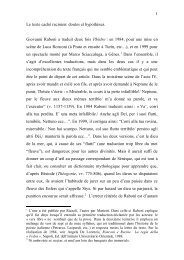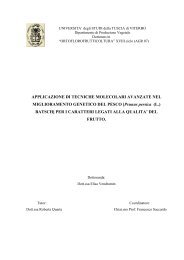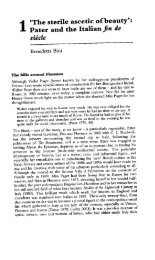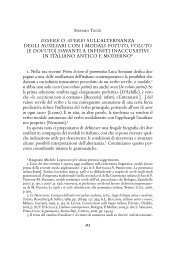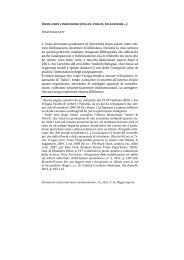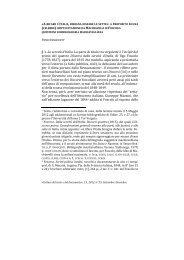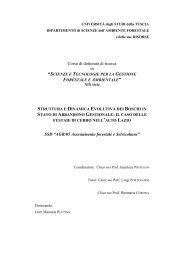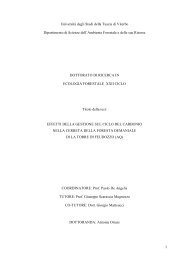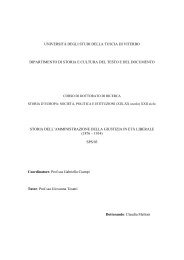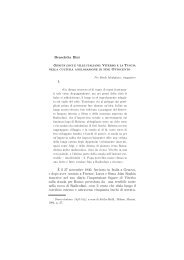drivers of soil respiration of root and microbial ... - Unitus DSpace
drivers of soil respiration of root and microbial ... - Unitus DSpace
drivers of soil respiration of root and microbial ... - Unitus DSpace
You also want an ePaper? Increase the reach of your titles
YUMPU automatically turns print PDFs into web optimized ePapers that Google loves.
Soil enzymatic activity<br />
Criteria for choosing enzyme assays were based on their sensitivity to <strong>soil</strong> management,<br />
importance in nutrient cycling <strong>and</strong> SOM decomposition.<br />
Enzyme activity was measured according to the method <strong>of</strong> Marx et al. (2001) <strong>and</strong><br />
Vepsäläinen et al. (2001), partially modified, <strong>and</strong> based on the use <strong>of</strong> fluorogenic<br />
methylumbelliferyl (MUF)- <strong>and</strong> (AMC)- substrates. The <strong>soil</strong> was analysed for β-cellobiohydrolase<br />
(exo-1,4-β-glucanase, EC 3.2.1.91), N-acetyl-β-glucosaminidase (EC 3.2.1.30), β-glucosidase (EC<br />
3.2.1.21), α-glucosidase (EC 3.2.1.20), acid phosphatase (EC 3.1.3.2), β- xylosidase (EC 3.2.2.27),<br />
arylsulphatase (EC 3.1.6.1) <strong>and</strong> leucine-aminopeptidase (EC 3.4.11.1). The respective substrates<br />
were 4-MUF-β-D-cellobioside, 4-MUF- N-acetyl-β-glucosaminide, 4- MUF - β-D-glucoside, 4-<br />
MUF - α-D-glucoside, 4- MUF -phosphate, 4- MUF -7-β-D-xyloside, 4- MUF -sulphate <strong>and</strong> L-<br />
leucine-7- amino-4-methylcoumarin. 2.0g <strong>of</strong> fresh <strong>soil</strong> were homogenised in 100ml <strong>of</strong> 0.5M acetate<br />
buffer, pH 5.5, using an Ultra Turrax IKA for 3 minutes at 9600 rev/min. Aliquots <strong>of</strong> 100 µl <strong>of</strong><br />
diluted <strong>soil</strong> were pipetted in a 96 multiwell plate with three replicates. Each substrate was added in<br />
each well in aliquots <strong>of</strong> 100 µl for a final concentration <strong>of</strong> 500 µM; then the microplates were<br />
incubated at 30 °C for 3 hours, with fluorescence readings occurring every 30 minutes. For the<br />
calibration curve 0, 0.05, 0.1, 0.2, 0.4, 0.6, 0.8, 1 nmoles <strong>of</strong> MUF or AMC, for leucine-<br />
aminopeptidase, were added to the same aliquots <strong>of</strong> <strong>soil</strong> suspension to take into account the<br />
quenching effect on fluorescence intensity (Freeman et al., 1995). Fluorescence readings (excitation<br />
360 nm; emission 450 nm) were performed using a Fluoroskan Ascent (Thermo electron)<br />
fluorometer.<br />
The synthetic enzymatic index (SEI) was calculated following Dumontet et al. (1998) <strong>and</strong><br />
using specific enzyme activities releasing the same reaction product (MUF).<br />
Soil N mineralization (Short Nitrification Assay)<br />
Potential nitrification was measured after inhibition <strong>of</strong> N-NO2 - oxidation with sodium<br />
chlorate (10mM) according to the short nitrification assay (SNA) reported by Hopkins et al. (1988).<br />
Briefly, 2g <strong>of</strong> <strong>soil</strong> (60% WHC) were taken from each <strong>soil</strong> sample <strong>and</strong> were extracted with<br />
(NH4)2SO4 solution during 24h shaking. Extracts were centrifuged at 3800 rev per 20 min, then 1ml<br />
from each sample was transferred to 50 ml flasks together with diazotizing <strong>and</strong> coupling reagents.<br />
Colorimetric readings were performed on the spectrophotometer (UV mini 1240, UV-vis<br />
spectrophotometer, Shimadzu). To construct a calibration curve 0, 0.25, 0.5,1, 2, 3, <strong>and</strong> 4 ml were<br />
97




